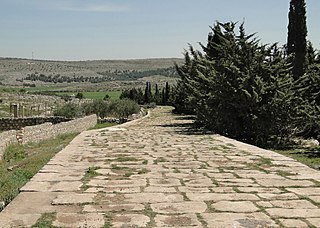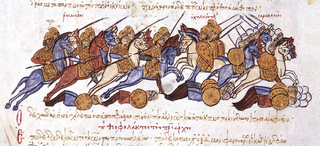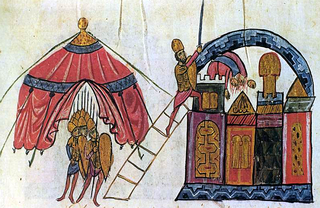Related Research Articles
John Kourkouas, also transliterated as Kurkuas or Curcuas, was one of the most important generals of the Byzantine Empire. His success in battles against the Muslim states in the East reversed the course of the centuries-long Arab–Byzantine wars and set the stage for Byzantium's eastern conquests later in the century.

Between 780–1180, the Byzantine Empire and the Abbasid & Fatimid caliphates in the regions of Iraq, Palestine, Syria, Anatolia and Southern Italy fought a series of wars for supremacy in the Eastern Mediterranean. After a period of indecisive and slow border warfare, a string of almost unbroken Byzantine victories in the late 10th and early 11th centuries allowed three Byzantine Emperors, namely Nikephoros II Phokas, John I Tzimiskes and finally Basil II to recapture territory lost to the Muslim conquests in the 7th century Arab–Byzantine wars under the failing Heraclian Dynasty.

ʿAlī ibn ʾAbū'l-Hayjāʾ ʿAbdallāh ibn Ḥamdān ibn Ḥamdūn ibn al-Ḥārith al-Taghlibī, more commonly known simply by his honorific of Sayf al-Dawla, was the founder of the Emirate of Aleppo, encompassing most of northern Syria and parts of the western Jazira.

Qinnašrīn, was a historical town in northern Syria. The town was situated 25 km (16 mi) southwest of Aleppo on the west bank of the Queiq and was connected to Aleppo with a major road during Roman times.
Michael Bourtzes was a leading Byzantine general of the latter 10th century. He became notable for his capture of Antioch from the Arabs in 969, but fell into disgrace by the Emperor Nikephoros II Phokas. Resentful at the slight, Bourtzes joined forces with the conspirators who assassinated Phokas a few weeks later. Bourtzes re-appears in a prominent role in the civil war between Emperor Basil II and the rebel Bardas Skleros, switching his allegiance from the emperor to the rebel and back again. Nevertheless, he was re-appointed as doux of Antioch by Basil II, a post he held until 995, when he was relieved because of his failures in the war against the Fatimids.
Al-ʿAwāṣim was the Arabic term used to refer to the Muslim side of the frontier zone between the Byzantine Empire and the Umayyad and Abbasid Caliphates in Cilicia, northern Syria and Upper Mesopotamia. It was established in the early 8th century, once the first wave of the Muslim conquests ebbed, and lasted until the mid-10th century, when it was overrun by the Byzantine advance. It comprised the forward marches, comprising a chain of fortified strongholds, known as al-thughūr, and the rear or inner regions of the frontier zone, which was known as al-ʿawāṣim proper. On the Byzantine side, the Muslim marches were mirrored by the institution of the kleisourai districts and the akritai border guards.
The Battle of Azaz was an engagement fought in August 1030 near the Syrian town of Azaz between the Byzantine army, led by Emperor Romanos III Argyros in person, and the forces of the Mirdasid Emirate of Aleppo, likewise under the personal command of Emir Shibl al-Dawla Nasr. The Mirdasids defeated the much larger Byzantine army and took great booty, even though they were eventually unable to capitalise on their victory.

The Battle of Marash was fought in 953 near Marash between the forces of the Byzantine Empire under the Domestic of the Schools Bardas Phokas the Elder, and of the Hamdanid Emir of Aleppo, Sayf al-Dawla, the Byzantines' most intrepid enemy during the mid-10th century. Despite being outnumbered, the Arabs defeated the Byzantines who broke and fled. Bardas Phokas himself barely escaped through the intervention of his attendants, and suffered a serious wound on his face, while his youngest son and governor of Seleucia, Constantine Phokas, was captured and held a prisoner in Aleppo until his death of an illness some time later. This debacle, coupled with defeats in 954 and again in 955, led to Bardas Phokas' dismissal as Domestic of the Schools, and his replacement by his eldest son, Nikephoros Phokas.

The Battle of Raban was an engagement fought in autumn 958 near the fortress of Raban between the Byzantine army, led by John Tzimiskes, and the forces of the Hamdanid Emirate of Aleppo under the famed emir Sayf al-Dawla. The battle was a major victory for the Byzantines, and contributed to the demise of Hamdanid military power, which in the early 950s had proven a great challenge to Byzantium.

The Battle of Andrassos or Adrassos was fought on 8 November 960 between the Byzantines, led by Leo Phokas the Younger, and the forces of the Hamdanid Emirate of Aleppo under the emir Sayf al-Dawla. It was fought in an unidentified mountain pass in the Taurus Mountains.
Abu 'l-Ma'ali Sharif, more commonly known by his honorific title, Sa'd al-Dawla, was the second ruler of the Hamdanid Emirate of Aleppo, encompassing most of northern Syria. The son of the emirate's founder, Sayf al-Dawla, he inherited the throne at a young age and in the midst of a major offensive by the Byzantine emperor Nikephoros II Phokas that within two years conquered the western portions of his realm and turned Aleppo into a tributary state. Facing a multitude of rebellions and desertions until 977, Sa'd was unable even to enter his own capital, which was in the hands of his father's chief minister, Qarquya. By maintaining close relations with the Buyids, he managed to re-establish his authority in parts of the Jazira, but his rule was soon challenged by the rebellion of his governor Bakjur, who was supported by the Fatimids of Egypt. In turn, Sa'd came to rely increasingly on Byzantine assistance, although he continued to fluctuate in his allegiance between Byzantium, the Buyids, and the Fatimids.
Bakjur was a Circassian military slave who served the Hamdanids of Aleppo and later the Fatimids of Egypt. He seized control of Aleppo in 975 and governed it until 977, when the rightful Hamdanid ruler, Sa'd al-Dawla, regained it. Given the governorship of Homs, in 983 he went over to the Fatimids and launched an attack on Aleppo, which was defeated through the intervention of Byzantine troops. Bakjur then became governor of Damascus for the Fatimids until 988. He made a last attempt to capture Aleppo in 991, which again was defeated thanks to Byzantine assistance. Bakjur was captured by Sa'd al-Dawla and executed.
The Battle of Alexandretta was the first clash between the forces of the Byzantine Empire and the Fatimid Caliphate in Syria. It was fought in early 971 near Alexandretta, while the main Fatimid army was besieging Antioch, which the Byzantines had captured two years previously. The Byzantines, led by one of Emperor John I Tzimiskes' household eunuchs, lured a 4,000-strong Fatimid detachment to attack their empty encampment and then attacked them from all sides, destroying the Fatimid force. The defeat at Alexandretta, coupled with the Qarmatian invasion of southern Syria, forced the Fatimids to lift the siege and secured Byzantine control of Antioch and northern Syria.
The Jarrahids were an Arab dynasty that intermittently ruled Palestine and controlled Transjordan and northern Arabia in the late 10th and early 11th centuries. They were described by historian Marius Canard (1888–1982) as a significant player in the Byzantine–Fatimid wars in Syria who "created for themselves, in their own best interests, a rule of duplicity, treason and pillage". They were the ruling family of the Tayy tribe, one of the three powerful tribes of Syria at the time; the other two were Kalb and Kilab.

The Byzantine conquest of Cilicia was a series of conflicts and engagements between the forces of the Byzantine Empire under Nikephoros II Phokas and the Hamdanid ruler of Aleppo, Sayf al-Dawla, over control of the region of Cilicia in southeastern Anatolia. Since the Muslim conquests of the 7th century, Cilicia had been a frontier province of the Muslim world and a base for regular raids against the Byzantine provinces in Anatolia. By the middle of the 10th century, the fragmentation of the Abbasid Caliphate and the strengthening of Byzantium under the Macedonian dynasty allowed the Byzantines to gradually take the offensive. Under the soldier-emperor Nikephoros II Phokas, with the help of the general and future emperor John I Tzimiskes, the Byzantines overcame the resistance of Sayf al-Dawla, who had taken control of the former Abbasid borderlands in northern Syria, and launched a series of aggressive campaigns that in 964–965 recaptured Cilicia. The successful conquest opened the way for the recovery of Cyprus and Antioch over the next few years, and the eclipse of the Hamdanids as an independent power in the region.

The Mesopotamian campaigns of John Tzimiskes were a series of campaigns undertaken by the Byzantine emperor John I Tzimiskes against the Fatimid Caliphate in the Levant and against the Abbasid Caliphate in Syria. Following the weakening and collapse of the Hamdanid Dynasty of Aleppo, much of the Near East lay open to Byzantium, and, following the assassination of Nikephoros II Phokas, the new emperor, John I Tzimiskes, was quick to engage the newly successful Fatimid Dynasty over control of the near east and its important cities, namely Antioch, Aleppo, and Caesarea. He also engaged the Hamdanid Emir of Mosul, who was de iure under the suzerainty of the Abbasid Caliph in Baghdad and his Buyid overlords, over control of parts of Upper Mesopotamia (Jazira).
Qarghuyah or Qarquya was an important Arab administrator in the Hamdanid Dynasty under Sayf al-Dawla, who would go on to control Aleppo himself and even sign the Treaty of Safar with the Byzantine Empire as the ruling emir of Aleppo.

The siege of Antioch in 968–969 was a successful military offensive undertaken by leading commanders of the Byzantine Empire in order to reconquer the strategically important city of Antioch from the Hamdanid Dynasty.

The siege of Aleppo was a siege of the Hamdanid capital Aleppo by the army of the Fatimid Caliphate under Manjutakin from the spring of 994 to April 995. Manjutakin laid siege to the city over the winter, while the population of Aleppo starved and suffered from disease. In the spring of 995, the emir of Aleppo appealed for help from Byzantine emperor Basil II. The arrival of a Byzantine relief army under the emperor in April 995 compelled the Fatimid forces to give up the siege and retreat south.

The sack of Aleppo in December 962 was carried out by the Byzantine Empire under Nikephoros Phokas. Aleppo was the capital of the Hamdanid emir Sayf al-Dawla, the Byzantines' chief antagonist at the time.
References
- 1 2 3 4 5 6 Todt & Vest 2014, p. 189.
- ↑ Kaldellis, Anthony. Streams of Gold, Rivers of Blood: The Rise and Fall of Byzantium, 955 A.D. to the First Crusade. Oxford University Press. pp. 74–75. ISBN 0190253223.
- 1 2 Honigmann 1935, pp. 94–95.
- ↑ Honigmann 1935, pp. 94–96.
- 1 2 3 4 Todt & Vest 2014, p. 190.